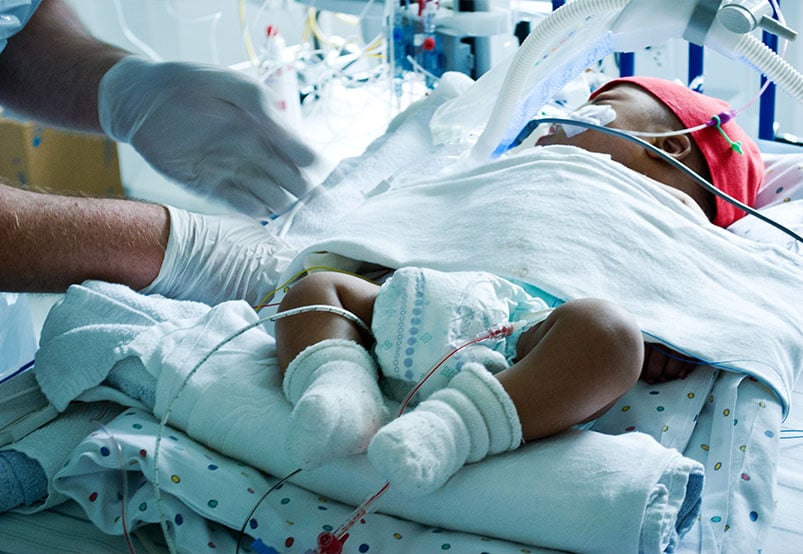
Patients lose sleep over them. Nurses run from room to room to silence them. Family members even learn to “help” by turning them off themselves.
We should all be alarmed about the state of alarms in hospitals today. Depending on acuity, nurses may receive anywhere from 350 to 800 alarms per patient per day – 90 percent of which do not require intervention. It’s easy to see why this results in alarm fatigue, which then leads to missed alarms, which is a real problem. In 2012, the Joint Commission reported 98 alarm-related sentinel events between January 2009 and June 2012, 80 of which resulted in death.
Important for Patient Safety
Included among the 2020 National Patient Safety Goals from The Joint Commission is improving clinical alarm safety. In fact, “Alarm, Alert, and Notification Overload” was listed as a top-ten “Health Technology Hazard” by The Joint Commission and the ECRI Institute for 2020:
Alarm, alert and notification overload focuses on the cumulative cognitive load of all the notifications that clinicians experience and how it affects their work. The global notification burden should be considered as a factor that can affect work, along with time pressures and competing administrative or clinical tasks.
Meeting these goals is hard: Data is not easy to come by, evidence-based guidelines on alarms is scarce, there is no one-size-fits-all solution for every unit, and changing behavior is an uphill battle. And who has time to manage the problem?
Alarm management tools help, but there are gaps: Many are retrospective only and don’t factor in the ever-changing patient population. Many do not provide all the data, such as information coming from non-networked devices like ventilators, or high-fidelity data such as waveforms. Also, many require management of multiple interfaces or lengthy excel based reports that aren’t easily manageable to get the data clinicians and alarm committees need to make educated decisions.
Better Patient Risk Management
On a macro level, better alarm management leads to the kind of clinical communications excellence that helps run a hospital at high efficiency and further reduce patient risk.
Real-time aggregation of a hospital’s alarm state is important to recover lost revenue, remove manual processes, reduce length of stay, reduce time to intervention, improve care delivery and team communication, and reduce patient risk.
How do we solve this complex problem?
The first step is an application that gives visibility to the hospitals entire alarm state to accurately target where alarm problems occur. A dashboard view allows managers and other members of the alarm committee to see a clear, institutional-level view of all alarms across all units in the hospital. This picture allows hospitals to understand the most frequent alarms by unit, obtain key performance indicators across the units, and see time in flood to help prioritize staff assignments. Knowing which beds alarm most frequently, and which nursing staff may be suffering most from too many alarms, allows management to take action.
The second step is focusing on the actual patients. Alarms are never “one and done.” Even if settings are changed at a macro level, or with a shift in staff, the change in patient population will necessitate ongoing maintenance of alarms. The fact is 80 percent of alarms come from approximately 30 percent of the patient population in the unit, especially in critical care environments.
To move the needle in reducing overall noise as well as patient risk, a patient-centric approach to alarm management is necessary. That approach combines integration of real-time data targeting patients with the highest number of alarms with dashboards that feature histograms of patient trends and decision support tools that provide recommendations.
Texas Children’s Hospital, one of the nation’s leading pediatric institutions, used both of these dashboard tools and a dedicated staff to meet their needs and achieved outstanding results: They met National Patient Safety Goals in six months, reduced time and alarm flood by 50 percent, and reduced alarm noise by 45 percent. They found that this allowed the nursing staff more time to spend on clinically relevant alarms and patient care.
Providing Context with Alarms to Expedite Care and Intervention
The next step - adding context to the alarms that are sent through.
Alarms of course are vital to patient care. The challenge is that often there isn’t enough information to determine if the alert is critical or not and how critical it is. Clinicians really need more context with the alert to expedite care and intervention. Specifically, they need to be able to view waveforms on their phones and not just a snippet in time, but the full context that led up to the alarm.
To examine this further, some of the key elements of waveform integration with alarms to consider include:
- link to full historical data so the clinician can scroll back to determine what led to the event;
- the ability to pull in other waveform data to the trend from other devices as well as alarms, alarm limits, and EMR data such as labs and meds to better determine root cause;
- the ability to link from that trend to see real-time waveforms across connected devices to confirm the patient’s current risk state;
- and then, the ability to share the trend data with their providers to expedite intervention.
Creating the Pathway for New, More Intelligent Alarms
Patient-centered alarm analytics and access to real-time and historical waveform data are the basic foundations of helping to reduce alarm noise, expedite care, and reduce patient risk. The next phase is starting to add intelligence to alarms to make them more meaningful and get ahead of deterioration and risk.
With the dawn of artificial intelligence (AI) and machine learning (ML) at our fingertips this new age is coming. It starts with having all the data available, with having tools to manage and modify it, and with a solution that allows any new alarms to be infused back into the environment.
Anything less than a complete approach only solves part of the problem. Anything less than all the data in real-time, and the context needed to take action, is actually kind of alarming in and of itself… isn’t it?




